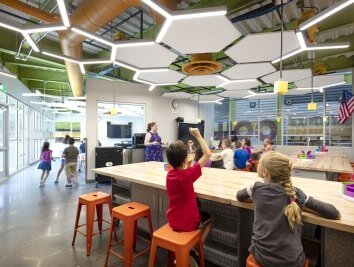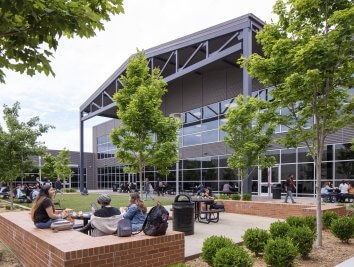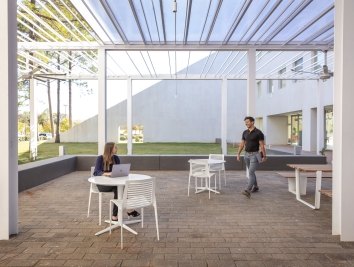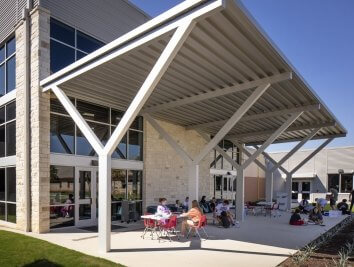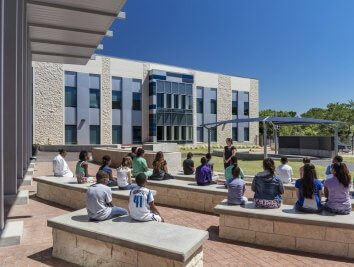Designing Educational Spaces for Mental and Emotional Health

As we’ve seen over the last year, external, global events such as COVID-19 can exacerbate stressors, intensify existing inequities, and create new challenges for everyone — including students. These additional stressors are piled on top of stressors students of all ages carry with them into the classroom under “normal” circumstances. There are stressors that students face that are part of growing up — such as increasing academic demands, the challenge of navigating social relationships, the pressure of meeting expectations, a growing desire for autonomy and independence, and the confusing process of self-discovery and identity formation (Magolda, 2008; Carolan et al, 2015). Beyond these shared developmental challenges, students also carry with them the challenges of their unique life circumstances — family instability, food insecurity, developmental differences, physical and mental health challenges, lack of resources or support, abuse, and more. Research shows that mood disorders, anxiety, and suicidal thoughts have increased along with academic pressure, social media use, isolation, and bullying (Walker, 2018; Blad, 2021). Each of these factors influences a student’s overall health and ability to learn.
Considering the diversity, complexity, and pervasiveness of stress in schools and its measurable impact on learning and health, it is essential for school facilities to provide holistic support for students and teachers. Learning environments need to be more than just a space to learn — they need to be restorative spaces that provide a sense of safety and security, respond to individual student's needs, and facilitate counseling and mentoring by staff and mental health professionals. By understanding the struggles and stressors students and staff might be carrying with them into the classroom, it is possible to implement design strategies that put health and wellness first, starting at the beginning of the design process.
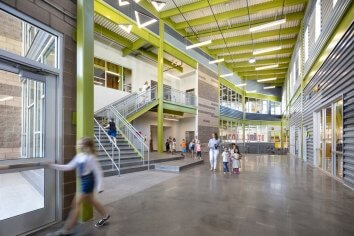
When design begins with a focus on health and wellbeing at the center of its process, educational practices and the design of learning environments can work together to meet the student's needs. A holistic perspective on education integrates academic, social, physical, cognitive, and self-development to build students’ global awareness and cultural competence, empathy, self-regulation, complex systems thinking, technological proficiency, creativity, and career decision self-efficacy (Stanford SRN, 2008; Magolda, 2008; Carolan et al, 2015; Immordino-Yang & Damasio, 2007). The focus given to these different skills and competencies communicates what’s important to students as they learn and grow (Stanford SRN, 2008). This suggests that a student’s learning environment needs to embody a holistic perspective on education. What better way to achieve this than to have a holistic perspective on learning and development embedded within the learning environment's design?
The physical learning environment can be an effective tool for supporting students’ health, wellbeing, and academic performance. However, it can also present its own sources of stress and discomfort that need to be identified and addressed. These potentially problematic features may include:
• Sensory factors
• Environmental quality
• Developmental misalignment
• Limited personalization
• Perception of safety and cleanliness
• Emotionally restrictive

Research conducted in psychology, cognitive science, neuroscience, and education offers insight that can help us address these considerations and inform the design of spaces for learning. Examining the learning environment as a whole and its impact on academic progress was the focus of the Holistic Evidence and Design Project (HEAD) conducted in the UK (Barrett et al, 2015). This study was able to isolate the impact of the physical classroom environment on learning, highlighting the importance of ownership, flexibility, connection, balanced visual complexity, and most markedly, “naturalness” factors such as light, air quality, and temperature for student success (Barrett et al, 2015).
Attention Restoration Theory (ART) and Stress Reduction Theory (SRT) present compelling evidence for the many benefits of integrating nature into the learning environment, including enhanced recovery from mental fatigue, reduction in ADHD symptoms in children, reduced stress, and improved physiological recovery (Kaplan, 1995, Ulrich et al, 1991; Ulrich, 1999; Berman et al, 2008; Kuo et al, 2004). When children play in nature, studies have documented improved mood and increased cooperative, constructive, and imaginative play (Dankiw et al, 2020; Merrill, 2020). Interestingly, these changes in play behavior translated to benefits in the classroom, including improved originality and imagination, improved focus, attention, concentration, timeliness, and decreased behavioral issues- compelling support for nature’s capacity to support a holistic perspective on education (Dankiw et al, 2020; Merrill, 2020).
By examining this research, we can identify significant relationships between our health and wellbeing, our environment, and important outcomes like learning and creativity. Mapping meaningful connections between research-based principles to designing learning spaces can inform effective design strategies for supporting mental and emotional health. Adopting a holistic perspective on education and design supports the wellbeing and success of the whole student through the quality of their sensory environment, the richness of their social and emotional environment, and the opportunities they have for self-development.
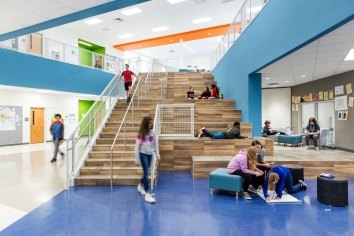
When we design with empathy, we think about individual students' needs and how the environment can provide support for everyone. To respond to the growing sources of stress that students face, we need to create space for restoration and relaxation in a society that glamorizes stress and burnout. Design should be focused on promoting health, wellbeing, and success and should seek to nurture and bring fulfillment to the whole student as they develop so that young minds can grow to reach their full potential.
In this three-part series, we will go over how the physical school building is causing stress for students and faculty, research-informed wellness-focused design strategies, and how to design educational buildings with empathy. Explore part 1 and part 2.
Universal Design, Accessibility, & Inclusion
Using Corgan’s work own with Professional Contract Services Inc. (PCSI) as a case study, our guest this week on TheSquare Podcast, Joseph LaRocca, Associate Principal at Corgan’s Austin office, will share what's to come for the future of accessibility. The project, both in client mission and design, showcases inclusivity and an empathetic approach to serving the unique needs of people with abilities. PCSI is a nonprofit with a mission to help veterans and those with disabilities secure meaningful jobs—bringing front and center features that expand accessibility such as a central ramp that anchors the design for the facility. Rather than approaching accessibility as a checklist, the project probes the possibilities of design to create an experience that is accessible and usable by everyone. Tune in as we explore what it means be more inclusive and create responsible spaces that expand our notion of sustainable design beyond green features and LEED certification and instead consider spaces that are not only accessible but also celebrate the various abilities and contributions of everyone.
References and Sources
Barrett, P., Davies, F., Zhang, Y., & Barrett, L. (2015). The impact of classroom design on pupils' learning: Final results of a holistic, multi-level analysis. Building and Environment, 89, 118-133.
Berman, M. G., Jonides, J., & Kaplan, S. (2008). The cognitive benefits of interacting with nature. Psychological science, 19(12), 1207-1212.
Blad, E. (2021, January 15). Schools grapple with student depression as data show problem worsening. Retrieved February 11, 2021, from https://www.edweek.org/leadership/schools-grapple-with-student-depressi…
Carolan, B. V., Weiss, C. C., & Matthews, J. S. (2015). Which middle school model works best? Evidence from the early childhood longitudinal study. Youth & Society, 47(5), 591-614.
Immordino‐Yang, M. H., & Damasio, A. (2007). We feel, therefore we learn: The relevance of affective and social neuroscience to education. Mind, brain, and education, 1(1), 3-10.
Kaplan, S. (1995). The restorative benefits of nature: Toward an integrative framework. Journal of Environmental Psychology, 15(3), 169-182. doi:10.1016/0272-4944(95)90001-2
Kuo, F. E., & Faber Taylor, A. (2004). A potential natural treatment for attention-deficit/hyperactivity disorder: evidence from a national study. American journal of public health, 94(9), 1580-1586.
Magolda, M. B. B. (2008). Three elements of self-authorship. Journal of College Student Development, 49(4), 269-284.
Stanford SRN. (2008). What is Performance-Based Assessment? Retrieved December, 2020, from https://edpolicy.stanford.edu/sites/default/files/events/materials/2011…
Ulrich, R. S., Simons, R. F., Losito, B. D., Fiorito, E., Miles, M. A., & Zelson, M. (1991). Stress recovery during exposure to natural and urban environments. Journal of environmental psychology, 11(3), 201-230.
Ulrich, R. S. (1999). Effects of gardens on health outcomes: Theory and research. Healing gardens: therapeutic benefits and design recommendation.
Walker, T. (2018, September 13). Are schools ready to tackle the mental health crisis? Retrieved February 11, 2021, from https://www.nea.org/advocating-for-change/new-from-nea/are-schools-ready-tackle-mental-health-crisis





